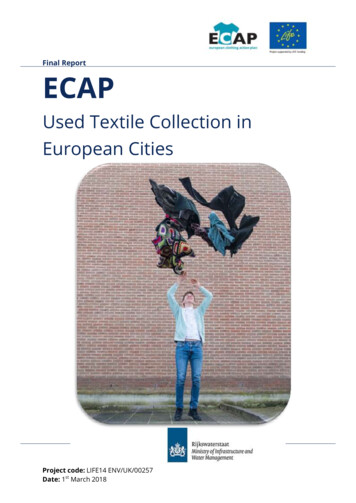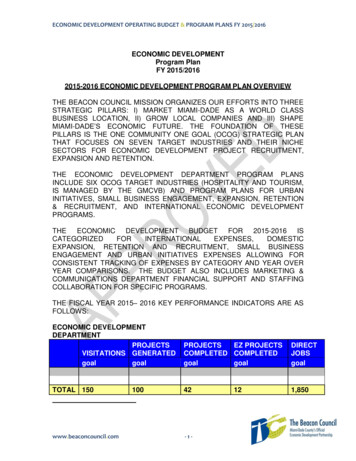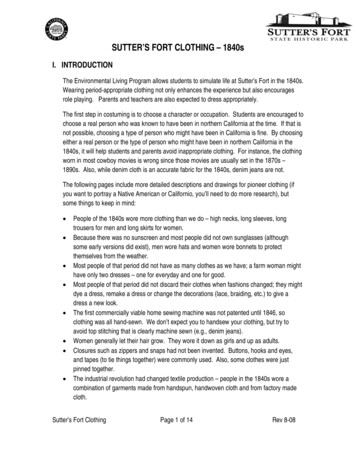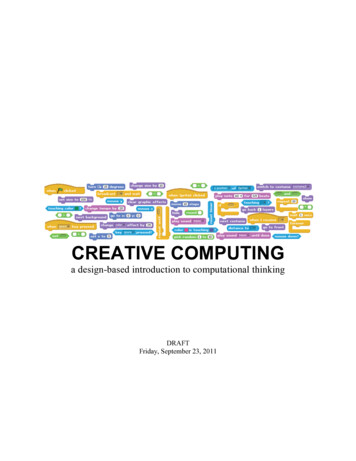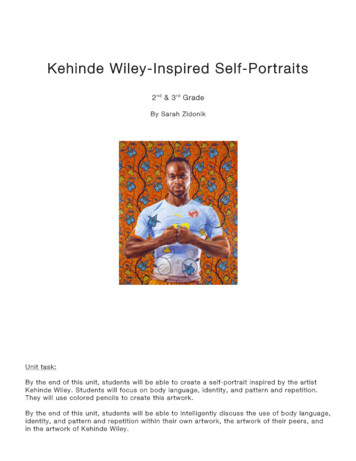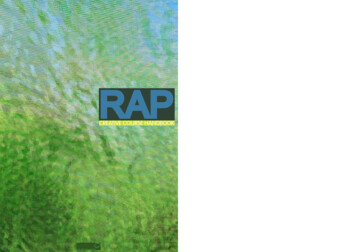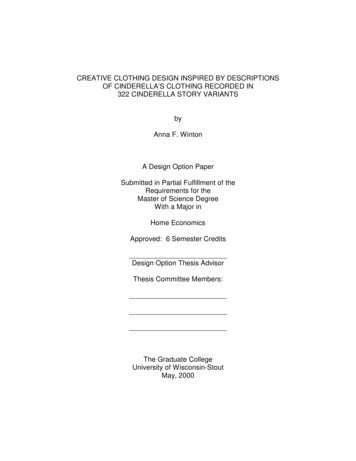
Transcription
CREATIVE CLOTHING DESIGN INSPIRED BY DESCRIPTIONSOF CINDERELLA’S CLOTHING RECORDED IN322 CINDERELLA STORY VARIANTSbyAnna F. WintonA Design Option PaperSubmitted in Partial Fulfillment of theRequirements for theMaster of Science DegreeWith a Major inHome EconomicsApproved: 6 Semester CreditsDesign Option Thesis AdvisorThesis Committee Members:The Graduate CollegeUniversity of Wisconsin-StoutMay, 2000
iiThe Graduate CollegeUniversity of Wisconsin-StoutMenomonie, WI 54751ABSTRACTWinton(Writer’s Last Name)Anna(First Name)F.(Middle Initial)CREATIVE CLOTHING DESIGN INSPIRED BY DESCRIPTIONS OF CINDERELLA’SCLOTHING RECORDED IN 322 CINDERELLA STORY VARIANTSHome Economics(Graduate Major)Donna Albrecht, Ph. D.(Research Advisor)May, 2000(Month/Year)56(No. of Pages)Publication Manual of the American Psychological Association (Fourth Edition)(Name of Style Manual Used in this Study)The purpose of this study was to design and create artistic, contemporary women’sgarments that creatively illustrated the themes expressed in descriptions of fairy taleheroine Cinderella’s clothing as recorded in traditional Cinderella variants. Descriptionsof the clothing worn by the Cinderella character in selected variants of the fairy talewere analyzed, and the 6 most frequently occurring themes found in the descriptionswere identified. These themes were metallic clothing, clothing resembling orornamented with celestial bodies, clothing resembling the sea, clothing ornamented withjewels, musical clothing, and clothing resembling or ornamented with flowers. Usingthese themes as sources of inspiration, 6 original designs for contemporary women’sclothing were sketched. Three of the proposed designs were created in fabric asfinished garments. The study concluded with a public exhibition of the finished
iiigarments, sketches, and a brief explanation of the thesis design project. The thesispaper was typed and produced according to the Publication Manual of the AmericanPsychological Association, Fourth Edition, copyright 1994.
ivTABLE OF CONTENTSPageABSTRACT. . . iiLIST OFFIGURES . . .viACKNOWLEDGEMENT. . viiCHAPTER I:INTRODUCTION .1Statement of theProblem .4Limitations . 5Definition ofTerms . .6CHAPTER II: REVIEW OFLITERATURE .7HistoricalOverview .7Motifs of the Cinderella Story and its Main TaleTypes . .10Cinderella’s Fine Clothing as Described in Variants Recorded byCox . .12CHAPTER III:METHODOLOGY .17Design ProcessOverview .17Sketches .17
vExecution of ClothingDesigns. .18Development of the Gold CoatDesign .25Development of the Sea DressDesign .27Development of the Sun DressDesign . 31
viCHAPTER IV: RESULTS ANDDISCUSSION . . .34Evaluation of FinishedDesigns . . . 34PresentationProcess .34Inviting the Public to View theDisplay . .38DisplayLayout . 41Presentation to thePublic . .42Evaluation of theDisplay .42CHAPTER V: SUMMARY, CONCLUSIONS, ANDRECOMMENDATIONS .45TheProblem . 45Methodology .45Results .45Conclusions andRecommendations .46REFERENCES .47
viiLIST OF FIGURESPageFigure 1: Sketch of Gold Coat andUnderdress . . .19Figure 2: Sketch of SeaDress. .20Figure 3: Sketch of SunDress .21Figure 4: Sketch of Moon and StarsDress . 22Figure 5: Sketch of Flowered LaceGown 23Figure 6: Sketch of RoseGown 24Figure 7: Photograph of Completed Gold CoatDesign 35Figure 8: Photograph of Completed Sea DressDesign .36Figure 9: Photograph of Completed Sun DressDesign 37Figure 10: Poster Advertising Public Display ofDesigns. .39Figure 11: FacultyInvitation 40Figure 12: Photograph of DisplayWindow .43Figure 13: Photograph of DisplayWindow . 44
viii
ixACKNOWLEDGEMENTI would like to extend heartfelt thanks to my wonderful thesis committee, thesisadvisor Dr. Donna Albrecht, Dr. Renee Lynch, and Professor Paul Stauffacher. I havefound their generous advice, suggestions, assistance, and positive attitudes to beinvaluable to me during the design option process. I would also like to thank Dr. T.Kathleen Cochran for permitting the use of the display space, mannequins, and props.Finally, I would like to thank my mother and my sister for contributing their ideas, hardwork, and encouragement during all phases of the process.
1CHAPTER IINTRODUCTIONFolktales, including the fairy tales read to children today, have existed forthousands of years in oral form as part of the cultural heritage of earlier civilizations(Minard, 1975; Zipes, 1984). Rather than being only entertainment for children, fairytales were traditional stories for adult audiences that addressed universal humanquestions, problems, and hopes in symbolic language (Mieder, 1997; von Franz, 1975).It is for this reason that fairy tales are still interesting to people today (Shah, 1979).Within them lie the “hope of self-transformation and a better world” (Zipes, 1984, p. ix).As a “highly developed form of art” (Lüthi, 1982, p. 97), fairy tales can inspire creativityby helping to “open the door to that part of our minds where anything is possible” (Shah,1979, p. xi).“Cinderella” is one of the most widely known and longest-enduring fairy tales(Clarkson & Cross, 1980; Dundes, 1982a; Heiner, 1999; Leeming, 1997; Shah, 1979;Sierra, 1992; Yolen, 1982). More than 700 variants of this tale have been recorded inthe folklore of many cultures around the world, especially those of Europe, Asia, and theMiddle East (Leeming, 1997; Rooth, 1951; Sierra, 1992). The oldest known writtenrecord of a Cinderella variant is a Chinese version dating to around 850 C.E. (Jameson,1982). The oral history of the tale is considerably older (Leeming, 1997).The Cinderella story has inspired “countless short stories, novels, plays,operettas, and films,” including Shakespeare’s King Lear (Dundes, 1982a, p. 229;Dundes 1982b). The tale has been called “one of the time-tested facets of the human
2spirit,” and its popularity has continued unabated into the twentieth century (Dundes,1982a, p. xvii; Schulte-Peevers, 1996; Sierra, 1992).One reason that the Cinderella story is so alluring to both children and adults isdue to its theme of triumph over adversity. In the story, clothing is usually the keyelement that makes this triumph possible. In almost all variants of the story, Cinderellauses her clothing to reveal and/or reinvent herself and to change her outwardcircumstances for the better. By revealing what she is really like on the inside,Cinderella’s change of clothes allows her to be recognized “for her true worth” (Heiner,1999, p. 1), “for the good and beautiful person that she really is” (Sierra, 1992, p. 3).Thus, the Cinderella story reveals certain ideas about the power of clothing tohelp us express ourselves and change our lives. These ideas have been confirmed byresearchers who have studied social and psychological aspects of clothing. Forexample, Giles and Charasse (1975) found that, in social interactions, how a personpresents himself or herself in terms of appearance is “relatively more powerful thanwhat he (she) claims to be” (p. 311). Lurie (1981) states that “to choose clothes . . . isto define and describe ourselves” (p. 5). According to Sproles and Burns (1994), people“often use clothing to communicate their unique self-concept and social identity” (p.194).The use of clothing as a means of self-expression in the Cinderella story holds apowerful appeal for both children and adults. Children love to play dress-up, and byexperimenting with clothing they explore possible future social roles (Horn, 1977).Adults like to dress up also; in doing so we can leave behind our everyday existenceand express neglected aspects of our personality.
3The clothing worn by Cinderella embodies the potential of self-expression andself-discovery. Perhaps this is the reason that the clothes in the fairy tale themselvesare so intriguing, not just to children but also to adults. It is not just little girls who wantto own clothes like those of Cinderella. After the 1998 premiere of 20th Century Fox’sremake of Cinderella, Ever After, the famous shoe design house of SalvatoreFerragamo sold custom-made replicas of the shoes it designed for actress DrewBarrymore to wear in the movie. The shoes were made with 2,000 beads and 1,000crystals secured with sterling silver thread. They sold for 2,500 (“Ferragamo Pushing,”1997).In 1949 Walt Disney released an animated film of what would become the mostfamous version of the Cinderella story ever told. The film grossed 4.247 million in thefirst release alone, and soon it was Disney’s version that came to mind for Americanswhenever the story was mentioned (Leeming, 1997; Yolen, 1982).However, as Dundes (1982a) explains, Disney’s version of the story is not veryrepresentative of the tale’s rich oral heritage. The Disney retelling of the tale has beencriticized for “reek[ing] of sexism, sentimentalism, and sterility” (Zipes, 1984; p. 115),and for denying the Cinderella heroine her traditional qualities of “shrewdness,inventiveness, and grace under pressure” (Yolen, 1982, p. 298). The Cinderella in mostAmericans’ minds is not the true Cinderella. As Yolen argues:The American “Cinderella” . . . is a spun-sugar caricature of her hardier Europeanand Oriental forbears, who made their own way in the world, tricking thestepsisters with double-talk, artfully disguising themselves, or figuring out a wayto win the king’s
4son. . . . [Since Disney’s version] America’s Cinderella has been a coy, helplessdreamer, a “nice” girl who awaits her rescue with patience and a song. ThisCinderella of the mass market books finds her way into a majority of Americanhomes while the classic heroines sit unread in old volumes on library shelves.(pp. 296-297)Robbins (1998), Shapiro (1997), and Stone (1975) also comment on the discrepancybetween modern mass-media versions of the story, including Disney’s, and moretraditional versions.Zipes (1984) suggests that to counter this “corporate inundation of ourimagination,” familiar versions of the fairy tale should be “made strange to us again” (p.105). Thus studying earlier, less-familiar versions of the fairy tale can spark increasedinterest in the tale as well as inspire creative thought.Authors such as Dundes (1982a), Robbins (1998), Shapiro (1997), Stone(1975), and Yolen (1982) have attempted to make the familiar versions of Cinderellastrange again by noting differences in the characteristics of the heroine and the overallplot of the story from those of more traditional versions of the tale. There are manydifferences between Disney’s and more traditional versions in the details of the fairy taleas well, such as the clothing that Cinderella wears to reveal her true self. Since the roleof clothing is such an important motif in the tale, it is not only interesting but alsoenlightening to explore the ways that traditional versions of the story have describedCinderella’s clothing.Zipes (1984) observes that fairy tales such as Cinderella “can be actively utilizedto stimulate critical and imaginative thinking” (p. x). Folk and fairy tales have providedinspiration for “numerous artists down the centuries” (Shah, 1979, p. xi). The
5descriptions of Cinderella’s clothing recorded in traditional versions of the fairy taleshould therefore provide a wealth of inspiration for creative clothing design.Statement of the ProblemThe purpose of this study was to design and create artistic, contemporarywomen’s garments that creatively illustrated the themes expressed in descriptions offairy tale heroine Cinderella’s clothing as recorded by folklorist Marian Roalfe Cox(1967). This study focused on the following objectives:1. To analyze descriptions of the fine clothing worn by the Cinderella characterin traditional Cinderella fairy tale variants as recorded by Cox (1967) in her bookCinderella: Three Hundred and Forty-five Variants of Cinderella, Catskin, and Cap o’Rushes, Abstracted and Tabulated, with a Discussion of Mediaeval Analogues, andNotes.2. To identify the most frequently occurring themes found in the writtendescriptions of Cinderella’s clothing.3. To create six sketches of proposed designs that creatively express theidentified themes.4. To execute three of the six proposed designs in appropriate fabrics.5. To exhibit to the public the finished garments, sketches, fairy tale excerpts,and a brief explanation of the thesis project.LimitationsThe following are important limitations of this study:
61. The study focused on the investigation of descriptions of the clothing worn bythe Cinderella character in the Cinderella fairy tale variants recorded by Cox (1967) inher aforementioned book. While there have been other traditional Cinderella variantscollected by various authors, with the notable inclusion of Rooth (1951), it is only Cox’scollection that provided sufficiently detailed written descriptions of Cinderella’s clothingfor the purposes of this study. Time constraints precluded the collection of individualversions of the Cinderella story as part of this study.2. Cox (1967) focused mainly on Cinderella variants from Europe recorded in theyears between 1544 and 1892 C. E. Cinderella stories have, however, been recordedin many non-European countries, including China, where the oldest known writtenversion of the Cinderella story was recorded around 850 C. E. (Jameson, 1982). Anexploration of descriptions of Cinderella’s clothing in non-European variants could provefascinating but was beyond the scope of the present study.3. While it is possible that this study may contribute in some small way to theunderstanding of the themes or overall meaning of the Cinderella fairy tale, the primaryfocus of this study was creative clothing design.Definition of TermsTale type: designation for a basic, recognizable story plotVariant: a regional way of telling a certain tale typeVersion: one actual telling of a tale, either oral or written
7CHAPTER IIREVIEW OF LITERATUREIn order to provide a context for analyzing recorded descriptions of the clothingworn by Cinderella, this review of literature will first briefly discuss the Cinderella story’shistory. Next, the distinguishing motifs of the Cinderella story and its main tale types willbe reviewed. Finally, the descriptions of Cinderella’s fine clothing recorded in thevariants collected by Cox (1967) will be summarized.Historical OverviewIn her extensive study, The Cinderella Cycle, Rooth (1951) attempted to trace thedevelopment and migration of the Cinderella story. Rooth theorized that the taleoriginated in Asia at least 4,000 years ago and migrated to Europe via the Near East.She proposed that in the Near East the evolving tale took on the motifs of fine clothingfrom the grave, the lost shoe, and the shoe test, while in southeastern Europe the motifof three visits to the feast or church in increasingly beautiful dresses was added.However, Sierra (1992) contends that “the arguments of Rooth and others [about thepossible origins of the tale] are not convincing,” and notes that most folklorists no longerattempt to discover the origins of the tale (p. 163).In the first century B.C.E., the Greek historian Strabo recorded a legend told inEgypt that contains some elements of the Cinderella story. The subject of the legend isa courtesan named Rhodopis who married the Pharaoh Amasis sometime during thesixth century B.C.E. (Bourboulis, 1982; Climo, 1989; Jameson, 1982). According toStrabo’s record, an eagle stole one of Rhodopis’s beautiful sandals while she was
8bathing. The eagle then flew to the city of Memphis where the Pharaoh was holdingcourt, and dropped the sandal into his lap. The Pharaoh searched for the owner of theshoe and married Rhodopis when he found her (Bourboulis, 1982; Jameson, 1982;Sierra, 1992).The oldest known complete version of the Cinderella story recorded in writingwas published in China by Tuan Ch’eng Shih around 850 C.E. (T’ang dynasty), makingit about 700 years older than the oldest written European version (Bourboulis, 1982).Moreover, Jameson (1982) notes that the telling of the tale suggests that its audiencealready knew the story well by the time it was written down. The Chinese Cinderella inTuan Ch’eng Shih’s book Yu Yang Tsa Tsu (The Miscellaneous Record of Yu Yang) iscalled Shen Hsien or Yeh-shen, depending on the system of translation used(Bourboulis, 1982; Heiner, 1999; Jameson, 1982; Leeming, 1997). This telling of thestory includes mistreatment by the stepfamily, help from a magical talking fish, thefestival where Shen Hsien loses her golden shoe, “bluish finery,” and the king whodetermines to marry the owner of the shoe (Jameson, 1982, p. 76).The oldest published European version of the Cinderella story was written in1550 by the Italian Francesco Straparola in his collection of tales entitled Piacevolti Notti(Favat, 1977; Jeter, 1984; Yolen, 1982). Eight years later, another version waspublished in Lyon in Bonaventure des Périers’ Les Nouvelles Récréations et JoyeuxDevis (Jameson, 1982; Sierra, 1992). In 1634-1636, a third European version entitled“La Gatta Cenerentola” (“The Cat Cinderella”) was published posthumously inGiambattista Basile’s book Il Pentamerone (Favat, 1977; Sierra, 1992). In Basile’sNeopolitan version, a fairy emerges from a date tree and tells the heroine to go to thetree to receive beautiful clothing (Basile, 1982; Dundes, 1982a).
9The most well known European literary version of the Cinderella tale,“Cendrillon,” was written by Charles Perrault, a member of the court of King Louis XIV ofFrance. Perrault’s collection of fairy tales was published in 1697 under the title Historiesou Contes du Temps Passé, avec des Moralités (Stories or Tales from Times Past, withMorals), with the alternate title Contes de Ma Mère L’Oye (Tales of Mother Goose)(Dundes, 1982a; Favat, 1997; Sierra, 1992; Yolen, 1982). Sierra (1992) remarks thatPerrault gives a “very idiosyncratic retelling of the oral tale” (p. 149). Jeter (1984) notesthat Perrault created an “obedient and passive” Cinderella for his royal court audience(p. 235). Perrault also added the fairy godmother, the pumpkin carriage, the animalservants, and the glass slipper to the story (Heiner, 1999). The following is an excerptfrom Perrault’s “Cendrillon”:Then said the fairy godmother:“Well, there you have the means of going to the ball. Are you satisfied?”“Oh, yes, but am I to go like this in my ugly clothes?”Her godmother merely touched her with her wand, and on the instant her clotheswere changed into garments of gold and silver cloth, bedecked with jewels. Afterthat her godmother gave her a pair of glass slippers, the prettiest in the world.(Perrault, 1969, pp. 70-71)It was Perrault’s version of Cinderella upon which Walt Disney’s 1949 animated film wasbased (Sierra, 1992).Another well-known version of Cinderella appeared in Jacob and WilhelmGrimm’s Kinder-und Hausmärchen (Children’s and Household Tales), first published in1812 in Germany (Brynteson, 1999). The Grimms’ version, “Aschenputtel” (“Ash Girl”),does not include a fairy godmother. Instead, as in many versions from the oral tradition,
10the heroine plants a tree on her mother’s grave after which a white dove appears andgrants the heroine magical help (Heiner, 1999). The Grimms told the story in this way:When everyone had gone, Ash Girl went to her mother’s grave under the hazelbush and cried,“Little tree, jiggle yourself and shake yourself,Scatter gold and silver over me.”Then the bird threw down a gold and silver dress and silk slippers embroideredwith silver. She put the dresses on in a hurry and went to the festival. (Grimm &Grimm, 1982, p. 26)In the Grimms’ story, Ash Girl attends the festival on three separate occasions, wearingprogressively finer clothing each time. On the last occasion, Ash Girl wears slippers “ofsolid gold” (Grimm & Grimm, 1982, p. 27).Other important developments in the history of the Cinderella story in theWestern world include the composer Gioachino Rossini’s 1817 opera “La Cenerentola,”Rodger and Hammerstein’s musical theater production, and of course Disney’sanimated motion picture (Brynteson, 1999). In each retelling, the story’s details wereinfluenced by the culture, setting, and time of the teller and the intended audience(Jeter, 1984).Motifs of the Cinderella Story and its Main Tale TypesFolklore scholars Aarne and Thompson (1961) created an internationallyaccepted system of cataloging about 2,500 tale types, including three Cinderella taletypes. They classify Cinderella tales as those that include the following elements: apersecuted heroine, magical aid, a meeting with a prince, a test of identity, and
11marriage with the prince. As Sierra (1992) notes, “stories belonging to Aarne andThompson’s three main Cinderella tale types . . . actualize this sequence of episodes indifferent ways” (p. 162).Aarne and Thompson’s three main Cinderella tale types are type 510A, type510B, and type 511. Tale type 510A (Cinderella) is classified by the following motifs:persecution by female relatives, help from the heroine’s dead mother, meeting of theprince at a ball or church, and recognition of identity through a shoe/slipper test. Taletype 510B (The Dress of Gold, of Silver, and of Stars) contains these components:persecution by the heroine’s father, dresses given by her father, meeting with the princewhen in disguise as a servant working in the prince’s house, another meeting with theprince at a ball or church, and recognition through a shoe or a ring. Tale type 511 (Oneeye, Two-eyes, Three-eyes) includes persecution by female relatives, aid from ananimal and/or an old woman, spying by the heroine’s sisters, a treasure tree, andrecognition of the heroine by her ability to pick the fruit of the tree (Aarne & Thompson,1961; Sierra, 1992).In 1892 Marian Roalfe Cox (revised 1967) published an extensive, book-lengthstudy of the Cinderella story. In her book, Cox provided summaries of the 345 variantsof the tale she collected from books, journals, and the unpublished folklore archives ofvarious nations (Clarkson & Cross, 1980; Sierra, 1992).In 1892 when Cox originally wrote her book, Aarne and Thompson’s tale typeclassification system did not yet exist. Instead, Cox categorized the variants shecollected into five main types: type A, Cinderella proper; type B, Catskin; type C, Cap o’Rushes; type D, Indeterminate; and type E, Hero Tales. According to Cox, types A, B,and C all contain a mistreated heroine and recognition by means of a shoe. Type A
12(Cinderella proper) corresponds to the Aarne-Thompson tale type 510A (Cinderella).Types B (Catskin) and C (Cap o’ Rushes) are very similar and both correspond toAarne-Thompson tale type 510B (The Dress of Gold, of Silver, and of Stars). Cox’stype D (Indeterminate) contains elements common to all three of the previous groupsand thus cannot be differentiated as type A, B, or C. This type corresponds to theAarne-Thompson tale type 511 (One-eye, Two-eyes, Three-eyes). Finally, Cox’s type E(Hero Tales) contains Cinderella-like tales in which the main character is male ratherthan female (Aarne & Thompson, 1961; Cox, 1967).Cox’s 23 Hero Tales (type E) were excluded from analysis in this study. Afterthis, a total of 322 variants remained for analysis. These included 134 Cinderella (typeA) variants, 81 Catskin (type B) variants, 27 Cap o’ Rushes (type C) variants, and 80Indeterminate (type D) variants (Cox, 1967).Variants of the different types may be distinguished by the manner in which theheroine obtains her fine clothing. In type A (Cinderella proper) variants, the mistreatedheroine is often given the dresses by a supernatural helper in the form of an animal, anold man, an old woman, a fairy, a fairy godmother, or a treasure tree that Cinderella hasplanted on her mother’s grave. In type B (Catskin) variants, the heroine’s father wantsto marry her. In an effort to hold off her father’s demands, the heroine requests threenearly impossible-to-obtain dresses, along with an unusual disguise. Once the heroinereceives the dresses and disguise from her father, she flees her home. In type C (Capo’ Rushes) variants, the heroine is cast out of her home by her father after she tells himthat she loves him “as meat loves salt.” In these variants, the heroine takes three of herown magnificent dresses with her from her home when she is cast out (Cox, 1967).
13As Cox’s type D (Indeterminate) variants combine elements of types A, B, and C,the manner in which fine clothing is obtained may occur in the manner of any of thesetypes. In some of the type D variants, clothing is not a significant part of the story andrecognition of the heroine instead occurs through her being the only person who is ableto pick the fruit of a magical tree (Cox, 1967).Cinderella’s Fine Clothing as Described in Variants Recorded by CoxExtensive analysis of clothing descriptions in the Cinderella variant summariesprovided by Cox (1967) revealed six main themes. These themes were (a) metallicclothing, (b) celestial clothing, (c) clothing resembling the sea, (d) clothing made ofjewels, (e) musical clothing, and (f) clothing made of flowers. These themes areexplained in detail in the paragraphs below.Much of the fine clothing (primarily dresses) worn by Cinderella in the variantsrecorded by Cox (1967) is described as being made of metallic material. In 64 variants,Cinderella wears gold or golden clothing. Examples of specific descriptions given of theclothing include a dress that “shines like gold” (p. 385), a dress “embroidered in goldwith as many stars as there are in the sky” (p. 334), “a dress steeped in golden vapours”(p. 394), “a robe of gold and diamonds” (p. 343), “dresses of pure gold” (p. 246), “agolden gown” (p. 147), “a dress of shining gold” (p. 312), “a gown of gold brocade” (p.239), a “gilded robe” (p. 395), and “a coat of beaten gold” (p. 189). Silver clothing alsoappears frequently in the stories. Dresses made of silver or resembling silver arementioned in 42 variants in descriptions such as “a dress embroidered in silver” (p.334), “a gown . . . of silver brocade” (p. 239), and “a dress of silk and silver thread” (p.
14272). In three variants, a dress is described as being both gold and silver. Additionally,four copper dresses, three brass dresses, and one steel dress are mentioned.A celestial theme was also frequently observed in the descriptions. Forexample, in 35 variants a dress of the sun is mentioned. Specific descriptions includeda dress “with the sun embroidered on it” (Cox, 1967, p. 126), a dress “that shines likethe sun” (p. 127), “a dress like the sun” (p. 138), a dress “like sunlight” (p. 188), a dress“woven of . . . sunbeams” (p. 180), and a dress “of fine fabric ornamented with suns” (p.417). Thirty-one variants include descriptions of a dress of stars. Examples of thesedescriptions include a dress “wrought of all the stars of heaven” (p. 212), a dress “thatshines like the stars” (p. 127), a dress “like the stars” (p. 138), a dress “the colours ofstars woven with gold” (p. 184), a dress “the colour of air . . . covered with the stars ofheaven” (p. 194), “a dress of stars” made from diamonds and pearls (p. 313), a dresswith “all the stars of heaven upon it” (p. 130), and a dress “on which is embroidered theheaven with its stars” (p. 245). A moon dress is mentioned in 28 variants in descriptionssuch as a dress “woven of . . . moonbeams” (p. 180), a dress “with the moonembroidered upon it” (p. 126), and a dress “like the moon” (p. 127).Sun, moon, and star dresses frequently appear together in the variants: all threeof these dresses are described in each of 17 variants in which the heroine wears one ofthe dresses for each of three occasions. In 14 other variants, the sun, moon, and starsor combinations of any two of these elements are combined in one dress. Descriptionsof these dresses include “a dress like the heavens with the sun, moon, and stars” (Cox,1967, p. 217), “a dress with the sun, moon, stars and all the heavens upon it” (p. 130),“a robe which shows the sun by day and the moon by night” (p. 353), and “a dressembroidered with the sun in front and the moon at the back” (p. 149).
15The sky dresses described in 12 variants are also evidence of a celestial theme.Examples of these include a dress of “sky-blue with gold stars ” (Cox, 1967, p. 436), a“dress like the sky, covered with golden stars” (p. 166), a “sky-blue dress” (p. 368), adress “the colour of the sky embroidered in gold and precious stones with the sun, themoon, and all the planets” (p. 350), a dress “the colour of noontide sky all covered withstars” (p. 181), and a “dress the colour of sky woven with silver” (p. 184). Additionally, a“dress like the dawn” is mentioned in one variant (p. 190).Descriptions of dresses made of jewels also frequently appear in the stories. In18 variants, the heroine wears a gown made with diamonds, pearls, or other preciousstones. Descriptions of these garments include a dress “that will stand alone withjewels” (Cox, 1967, p. 156), a “dress of pearls and diamonds” (p. 167),
CREATIVE CLOTHING DESIGN INSPIRED BY DESCRIPTIONS OF CINDERELLA’S CLOTHING RECORDED IN 322 CINDERELLA STORY VARIANTS by Anna F. Winton A Design Option Paper Submitted in Partial Fulfillment of the Requirements for the Master of Science Degree With a Major in Home Economics Approved:

